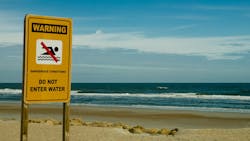New report reveals 61% of tested beaches had potentially unsafe contamination in 2024
As millions of Americans return to the beach this summer, a new report released on July 8, 2025, warns that more work is needed to ensure that all waters are safe for swimming. In 2024, 453 beaches were potentially unsafe for swimming on at least 25 percent of days tested, according to the latest Safe for Swimming? report by Environment America Research & Policy Center and Frontier Group. The new research comes as Congress considers funding for the main federal program to stop sewer overflows.
“Enjoying the fresh sea breeze and splash of waves at the beach is a highlight of the summer for many Americans, but pollution still plagues too many of the places where we swim," said John Rumpler, clean water director for Environment America Research & Policy Center and a co-author of the report, in a press release. "Now is not the time to slash the water infrastructure funding that communities sorely need to stop the flow of nasty bacteria and pollution to our beaches.”
For people who want to know if their favorite beach is currently safe for swimming, the new report also includes information on how to find the latest beach closings and health advisories in each state.
To assess beach safety, the group examined whether fecal indicator bacteria levels exceeded the U.S. Environmental Protection Agency’s (EPA) most protective “Beach Action Value,” which is associated with an estimated illness rate of 32 out of every 1,000 swimmers.
Pathogens posed risks in other waters as well. More than half of the 3,187 coastal and Great Lakes beaches reviewed exceeded the EPA threshold on at least one day they were tested in 2024, including:
- 54% of East Coast beaches
- 71% of Great Lakes beaches
- 84% of Gulf Coast beaches
- 79% of West Coast beaches
Scientists estimate 57 million instances of people getting sick each year from swimming in polluted waters in the United States. Those illnesses can include nausea, diarrhea, ear infections and rashes. Polluted runoff from roads and parking lots, overflowing or failing sewer systems, and industrial livestock operations are common sources of contamination that can put swimmers’ health at risk and lead authorities to close beaches or issue health advisories.
"We have the tools to make the water at our beaches safer for swimming," said Tony Dutzik, associate director and senior policy analyst at Frontier Group and a report co-author, in a press release. "We hope the maps and data in our report are used to identify places where pollution puts our health at risk and build momentum for solutions."
The report recommends major investments to stop sewage overflows and runoff pollution. Nature-based solutions such as vegetated buffers, rain barrels and constructed wetlands, and repair to aging systems yield cleaner water. Based on its survey of the states, the EPA estimates that managing our nation’s wastewater and stormwater will require at least $630 billion over the next 20 years. Yet the Clean Water State Revolving Fund is currently funded at less than 20 percent of that annual cost, and Congress could cut that funding even further.
“When Congress passed the Clean Water Act more than 50 years ago, our nation resolved that we would make all our waterways safe for swimming,” Rumpler said in a press release. “Congress should commit the resources needed to help states and communities achieve the goal of clean, safe water at all our beaches.”


